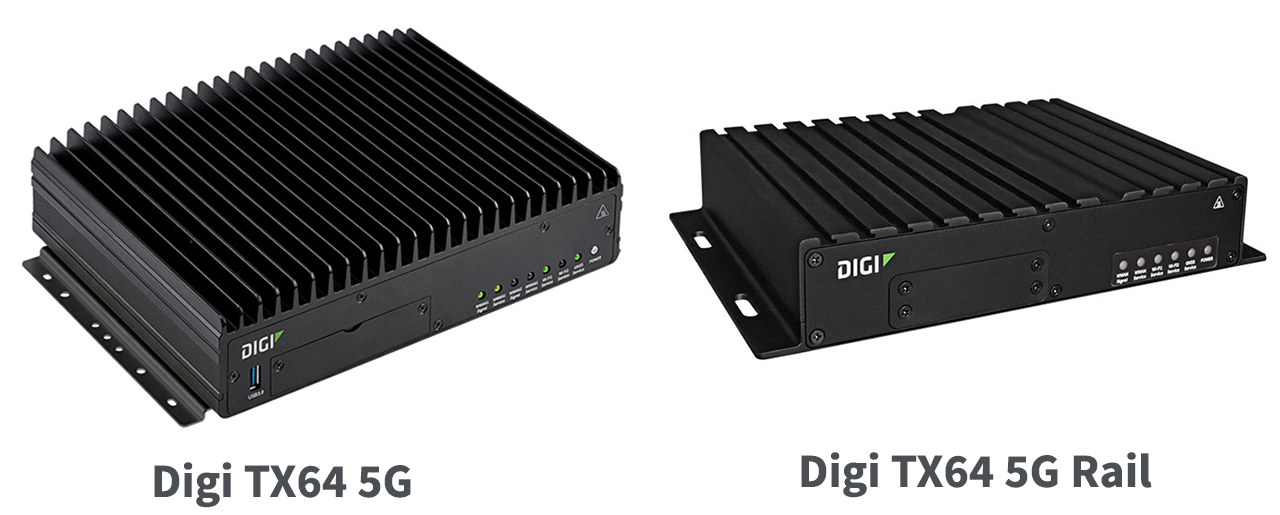Public transportation and commercial railway systems across the globe are in the process of upgrading nearly every aspect of their operations to boost ridership, provide a better passenger experience, and improve safety.
A key part of those upgrades involves wireless connectivity, which serves a steadily growing number of functions in transit. In this article, we’ll review some of the major issues that transit organizations, particularly those operating passenger rail, are facing, and highlight some of the ways that Digi solutions are helping them provide better, safer and more cost-effective service.
3G Shutdowns Drive Upgrades to 5G

The nationwide shutdowns of 3G networks by wireless carriers have been the impetus for many transit organizations to upgrade their wireless systems. Upgrading from 3G to 5G was the primary driver for the Southern Pennsylvania Transportation Authority (SEPTA), which provides light rail, subway and bus service for the Philadelphia metropolitan area.
SEPTA was one of the first transit organizations to install Positive Train Control (PTC), a sophisticated train-signaling system designed to prevent crashes and derailments, and track worker injuries resulting from speed and signal violations. In early 2021, SEPTA needed to prepare for their wireless carrier to shut down its 3G network, which their PTC system relied upon. They made the proactive choice to upgrade their technology to get ahead of the shutdowns.
So SEPTA turned to Digi to replace its Digi WR44 RR cellular routers, which had been in service since 2014. SEPTA first considered moving to a 4G LTE router. However, since a 5G router was available, they ultimately decided that the wisest choice was to upgrade their network to the most advanced unit available: the Digi TX64 5G Rail cellular router. By switching to the TX64 5G Rail, they future-proofed their cellular deployment for many years to come and also gained substantial improvements in performance.
5G Upgrade Benefits for Transportation

Let’s take a look at the benefits that SEPTA and organizations like it are seeing by upgrading to transportation and industrial cellular router solutions from Digi.
- Mission-critical communications: Another major benefit transit operators get with the new system is FirstNet®. FirstNet is the nationwide network that delivers priority, pre-emptive communications for first responders and critical infrastructure in the event of a natural disaster or large-scale public emergency. FirstNet was not available with the old 3G network and Digi TX64 5G Rail is the very first 5G true rail-rated product that is certified for use in the FirstNet system.
It’s worth noting here that AT&T, which operates FirstNet in a public-private collaboration with the First Responder Network Authority, now has a two-tier hierarchy of device compatibility with the FirstNet system: FirstNet Capable™ and FirstNet Trusted™ (which has more intensive certification requirements). Digi TX64 5G Rail is a FirstNet Trusted™ device, with all the security features that make it reliable in emergency situations.
- Network-wide visibility and management: Digi cellular routers are “all-in-one” solutions with integrated security via Digi TrustFence® and subscription-based remote configuration and monitoring with Digi Remote Manager®. This means they can all be rapidly configured, monitored for security with automated remediation in the event of unauthorized configuration changes, and monitored remotely 24/7/365.
- Location accuracy: Digi TX64 5G Rail is equipped with an Untethered Dead Reckoning (UDR) module that reports location data more precisely than traditional GPS. The UDR module uses inertial sensor data on the router to calculate a train’s exact position and speed, which is especially helpful anytime something blocks the GPS signal, such as when a vehicle is going through tunnels or underneath an overpass. UDR helps maintain the continuity that dispatchers and traffic management centers need to track their vehicles continuously.
The 3G shutdowns continue, so any transit system still relying on the older 3G technology will be faced with the same decision as SEPTA.
Transit Trifecta – 5G for Bus, Rail and Paratransit

Rail is a key component of public transportation in many regions. But in addition to rail and its various heavy and light rail transit (LRT) forms, city transportation systems typically include buses and paratransit services for mobility-impaired commuters. Paratransit vans are part of virtually every transit system’s fleet.
Digi offers 5G products that support the needs of all three of these different use cases. In the case of SEPTA, in addition to the Digi TX64 5G Rail routers that it uses on its trains, it also has Digi TX64 routers on buses and Digi TX54 for paratransit.
Future Opportunities with 5G and Rail

As 3G shutdowns progress in the U.S., network requirements are also evolving in other parts of the world. Europe, for example, is in the process of setting requirements for communication networks for railways as they upgrade from 3G-based GSM-R (Global System for Mobile Communications – Railway) to the new Future Railway Mobile Communication System (FRMCS).
Planners are in the last definition phase of what FRMCS is going to look like and what technology will be required. FRMCS is definitely going to be a 5G-based communication standard and passenger rail entities in Europe are already conducting trials with the Digi TX64 5G Rail. Deutsche Bahn in Germany has been partnering with Nokia and Digi is working with large integrators like Siemens. So 5G is on its way to Europe as well. That’s where the rail industry is going.
Upgrades Made Easy

When we developed and rolled out the Digi TX64 5G Rail cellular solution, we made sure it would be an easy upgrade from its predecessor, Digi WR44 RR. The Digi TX64 5G Rail router is a true “drop-in” next-generation replacement for WR44 RR. For example, if you remove a WR44 RR device from its mounting on a train, and replace it with a TX64 5G Rail, you’ll find that the bolt holes match up perfectly. We also have adapters that go from the TNC connectors of the slightly lower power consumption older unit to a slightly higher power consumption with the TX64. We offer all the accessories needed to make an easy swap.
For people who want to know more about the details of upgrading from WR44 RR, look for future articles in the Digi Knowledge Base for engineers and other IT professionals who will be performing the upgrades, or contact us to discuss the support you need and learn how our Professional Services team can help. In the meantime, visit our web page to learn more about Digi solutions for public transit.
Next Steps